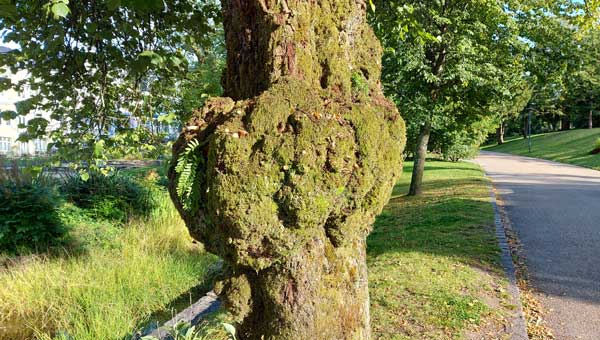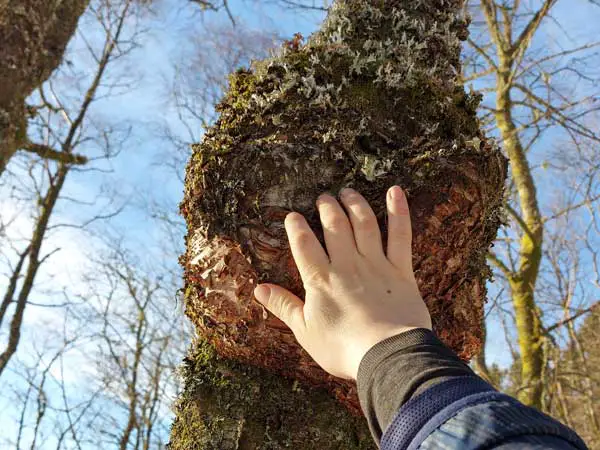Disclosure: This post may contain affiliate links, meaning I get a commission if you decide to make a purchase through my links, at no extra cost to you.
Burlwood is my favorite type of wood to work with. It is a mysterious type of wood that has a unique grain and pattern to it on the inside and looks strange on the tree.

A burl is a deformed growth on a tree caused by fungi, disease, or stress experienced by the tree. A burl can grow to be several tons, or be as small as a tennis ball. Burlwood is highly prized by woodworkers and crafters for the beautiful patterns of the wood
Let’s do a deep dive into understanding burls, how burls develop, why they are so valuable, and how you can find some burls to use for your woodworking projects, or just enjoy their beauty.
What is a Burl?
A Burl is any type of deformed growth that is developing on the tree. The burl can develop anywhere on the tree, this means that it can be found in the root system, the trunk, or any of the branches. The most common places to find burls are in the root system or at the trunk of the tree.
Burls are a result of the tree’s defense system and the burl starts to develop as a response to attacks from insects, fungi, or general stress from outside sources.
Burls can develop in several shapes and forms. The burls that develop above ground and up the tree trunk usually grow in a ball shape and in distinct spots on the tree. These are easy to identify when walking around the woods.
Burls developing at the root and stem of the tree are usually larger than burls that grow up the trunk or on the branches. They usually grow all the way around the roots and the trunk to protect the tree from dangers.
Why is Burl Wood so Valuable?
Burls are valuable because of their beauty and rarity. They are used to make beautiful and durable woodworking and crafting projects. Burlwood is hard to produce in large quantities and most burl wood is found and harvested in nature in an uncontrolled environment. This means that there will always be a limited amount of burl wood in circulation.
When you cut open a burl and see the inside pattern that is revealed you understand why so many woodworkers and crafters value burl wood and why it is so expensive. The grain of the burl has been disturbed and grows in a “deformed” manner. This means that it has no grain direction and the wood grows in all kinds of different directions. The result of this wild growth is some of the most beautiful wood patterns a tree can produce.
Burlwood is a hard and stable kind of wood because of the lack of grain direction. This makes the wood less prone to splitting in a certain direction compared to other types of wood. But since the burl has grown in such a deformed manner it is not unusual to find pockets of bark and dirt in the middle of the solid wood inside the burl.
With all these factors taken into account, burl wood becomes one of the most valuable wood types on the market. Large burls are usually the most valuable. The larger the better. The large burls are harder to find can be cut into the right size for your project, so it has more utilities.
Worlds largest Burl
The contender for the world’s largest burl is 6 meters tall and 6 meters wide and weighs an estimated 30 tons. The burl was found on a Sitka Spruce, this is a type of tree that grows fast and big. The burl is on display in Port McNeil in British Columbia. This website will tell you more about the world’s largest burl.
What Kind of Wood is A Burl?
A Burl is not specific to any kind of tree or type of wood. Most trees can develop burls as a response to stress, disease, or attacks. So when you hear people talking about burl wood they are not talking about a particular type of tree, they are just talking about a particular part of the tree.
Even though burls are not specific to any kind of tree there are trees that we associate more with burls than others. These trees commonly produce more burls than other tree species and have beautiful patterns inside.
List of Trees That is Associated with Burls
- Maple
- Birch
- Redwood
- Walnut
- Oak
- Cherry
- Elm
- Sitka Spruce
- Linden
- Chestnut
This is however not a complete list just some of the more usual ones to look out for. Most trees can produce burls. My all-time favorite type of burl is the Birch Burl.

Can You Remove A Burl from the tree?
In general, you should not remove a Burl from a tree. Removing a burl from a tree will leave an open wound in the tree and the tree will then be susceptible to infections and attacks by insects. This will in most cases lead to the death of the tree. There are however scenarios where harvesting burls might be acceptable.
Do you own the forest? Then it is your choice. But I would suggest cutting down the entire tree if you are going to harvest the burl.
Did you find a dying/fallen tree with a burl on it? Then it is also up to you. But use common sense. If I am in the woods in the middle of nowhere and I find a dying/fallen tree with a burl on it I would probably harvest it and take it home with me. Just don’t harvest any burls that are on someone else’s private property or from healthy trees.
How to identify a Burl?
Burls are easy to identify when you get to know them. Most large strange growths on tees can be called a burl. However, there are some different types of burls. I will show you some examples and images of a few different kinds of burls here.






6 Tips For Finding Burls
1. Go on a hike in the woods
You usually have to be in the woods to find a burl. Most people have some kind of forest in their area, go on a hike in the forest closest to you. Chance is that you will find some burls. But you will most likely not be able to harvest the burls on the most common paths and trails.
But at least you get to see some and investigate their shape so you know what to look for. You don’t even have to go in the woods to find burls if you just want to look at one. You can go to your local park or anywhere that has trees.
2. Look for uneven surfaces and lumps on trees
An uneven surface is the first sign to look out for when looking for burls. Most trees have a distinct way to grow and any formation that breaks this pattern is usually a burl. Burls are usually presented as spherical lumps when growing up the stem of the tree, but most uneven surfaces on the tree that has developed in a deformed manner may be classified as a burl.
3. Know what type of tree to look out for
Some general knowledge of trees comes a longs way. It is more common to find burls on some species of trees than others. In my area ( Norway ) I will look for Birch, Pine, Beech, and Sitka Spruce as top contenders for producing burls. But every area is different.
4. Go off the beaten path
This is where I find most of the burls I can actually harvest. Keep in mind that I only harvest from fallen and dying trees. But there are just way more burls if you go into the wild forest. The burls here can develop in peace and are safer from harvesting and disturbance in general.
If you have forests that are undisturbed by humans anywhere near you, this would be your best chance to find burls that you can actually harvest. But please don’t get lost in the woods. Use common sense when hunting for burls.
5. Look for biomes and environments that produce burls
Burls can develop anywhere where there are trees. But in my experience after hundreds of hours roaming the woods and looking for burls, I’ve noticed that some biomes and environments lead to trees developing burls more often. This might be because some environments are harsher for the trees and lead to more infections and attacks on the tree.
You develop a sense of which types of environments are good for finding burls in your area by practicing and continually looking for them wherever you go. As an example, in my area in western Norway, I go looking in shaded and moist forests. These type of forests seems to produce a lot of burls on the birch trees. And I have found many dead trees that I could harvest trees from.
6. If you find one burl, you will probably find more
If you find one burl in an area there is a big chance that there are more around. Stop in that area and have a good look for more burls and I can almost guarantee that you will find some. The reason for this is that if one tree has been exposed to fungi, insects, or any outside attacks the neighboring trees or branches probably have to do it as well.
Can Burl Wood Become Spalted?
Burlwood is just like any other type of wood and can start to spalt. This is a normal and natural process to decompose the wood. The wood gets infected with fungi and the fungi create beautiful black lines throughout the wood. If you want to read more about spalted wood: Check out this article
Because of the inconsistency in density in spalted wood, it can be hard to work with if the wood has started the spalting process. This makes spalted burl wood hard to work with, but it can become some of the most beautiful woodworking artworks.
What can you make with burl wood?
The true value of burl wood comes from the beautiful objects and artworks you can create with it. No item you create with burl wood will look the same, that is because of the unique patterns inside the wood.
List of common items created with burl wood
- Tables
- Vases
- Bowls
- Cabinets
- Pendants
- Candle Holders
- Cups
- Kuksa (Traditional Finish Cup )
Conclusion
Burls are strange and deformed growths on trees caused by fungi, insects, or other outside sources that damage the tree. They are beautiful to look at both on the inside and outside and should be left alone if on a living tree. They are highly-priced by woodworkers and crafters for the beautiful patterns of the wood.
